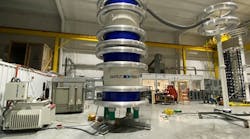S&C's new Circuit-Isolator II Disconnect is for use in distribution substations and anywhere an isolating disconnect is required. It is available in voltage ratings of 69 through 138 kV, and continuous current ratings of 1200, 1600, and 2000 A.
Circuit-Isolator II provides a three-pole, group-operated, visible-air-gap disconnect for your system. Although the isolator does not carry an interrupting rating, it can be used to interrupt low-level charging currents associated with substation buswork and circuit-breaker bushings, as well as other low-voltage currents commonly present in substations. It’s suited for use with S&C Trans-Rupter II Transformer Protector and S&C Type SMD Power Fuses. The Circuit-Isolator II is available in side-break, vertical-break, center-break, and double-break styles, lending itself to a wide range of substation layouts.
Circuit-Isolator II features aluminum blades (copper for models rated 2000 amperes) with silver-inlaid, hot-tin-dipped, high-conductivity cast-copper tongue contacts. The jaw contacts are of multi-finger, spring-loaded, silver-inlaid, hard-drawn copper reverse-loop construction. Built-in blade-wiping action ensures a clean current-carrying surface and low-resistance current path. Arcing associated with charging and magnetizing currents is confined to the arcing horns.
The Circuit-Isolator II can be applied with a Type LS-1 Switch Operator or can be applied with the new economical Type DS-1 Switch Operator, specially designed for use with the S&C Circuit-Isolator II Disconnect.
The Type DS-1 Switch Operator uses an electric motor with a geared torque-transfer system to drive the Circuit-Isolator II “Open” or “Closed” in 4 to 8 seconds, depending on the style and voltage of the disconnect. The operator has provisions for mechanically padlocking the disconnect in the open or closed position. A mechanical decoupling feature allows the operator to be exercised, permitting operational checkout of the control scheme without affecting the load. A variety of optional features are also available.



